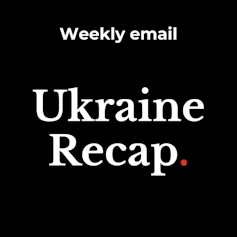Well before Vladimir Putin sent his war machine over the border into Ukraine, the Russian president and his proxies were fulminating about Nato surrounding his country, establishing hostile military bases in its backyard and boxing it into a corner.
Ukraine’s ever-closer relationship with the west and the prospect of it joining Nato was one of Russia’s great fears, along with resentment that Nato had attracted countries that were once firmly within the old Soviet sphere of influence. So the decision this week by Lithuania, one of the Baltic states, to enforce sanctions on certain goods moving between Russia and Kaliningrad, a small Russian “exclave” wedged between Poland and Lithuania on the Baltic Coast, has raised the temperature a notch.
As you’d expect, Russia’s rhetoric has been typically robust, threatening “appropriate measures” that would have a “serious negative impact on the population of Lithuania”. Moscow calls it a “blockade” – which has a specific meaning under the Geneva Convention, being prohibited if it is directly about starving a population. But, as Stephen Hall – who researches the post-Soviet space at the University of Bath – points out, this is no blockade. Non-sanctioned goods (including food and vital supplies) can still pass freely from Russia to Kaliningrad through Lithuania as can people. But reality has not played a huge part in Russia’s statements about the war to date.
Read more: Ukraine war: all eyes on Lithuania as sanctions close Russian land access to Kaliningrad
As it happens, Kaliningrad is where Russia’s Baltic fleet has its base. And one of the things that analysts are picking up on is the increasing focus on the maritime aspects of the conflict. By blocking Ukraine’s access to the Black Sea, Russia is exacerbating a global food shortage which is pushing up prices and threatening widespread hungers, particularly in Africa. But Basil Germond, an expert in sea power and maritime security at the University of Lancaster, reports that there is increasing evidence that Ukraine’s naval operations are causing problems for Russia’s navy as well as its civilian shipping operations. In a long war, writes Germond, sea power generally gives those countries wielding it an important advantage, and in this confrontation, Russia, a continental power, faces pressure from a range of seafaring nations, which will eventually contribute to Moscow’s strategic failure.

This is our weekly recap of expert analysis of the Ukraine conflict. The Conversation, a not-for-profit news group, works with a wide range of academics across its global network to produce evidence-based analysis. Get these recaps in your inbox every Thursday. Subscribe here.
The ground war
Back on dry land, the war of attrition in the Donbas region continues to be a struggle for every yard of territory. One aspect of this slow, bloody battle that is becoming clearer are the problems faced by Russia’s ground forces when it comes to crossing the various rivers in the region, particularly where – as is common – Ukrainian defenders have destroyed all the bridges.
As military strategist Christopher Morris from the University of Portsmouth writes, river crossings were a centrepiece of Soviet military tactics, featuring heavily in Red Army plans for pushing into Europe. Many of Russia’s armoured vehicles and tanks – amphibious by design – benefit from this legacy, and they have access to bridging equipment that should be fit for purpose. But like we have read so many times during Russia’s ill-conceived “special military operation”, poor planning, fiercer than expected Ukrainaian resistance and failure to control the air have meant that the Russian military is making a poor fist of river crossings, which is inflicting considerable harm on its campaign in the region.
Read more: Ukraine war: Russia's military campaign hindered by the rivers in Donbas
To the north meanwhile, there has been speculation that Russian ally Belarus might come to Putin’s aid – and certainly there has been a buildup of troops on the Belarus/Ukraine border, while Russia and Belarus have conducted joint exercises in the past. The University of Birminham’s Stefan Wolff and Anastasiya Bayok from the University of Hamburg, thinks it unlikely that Belarusian president, Alexander Lukashenko – who has faced enormous unrest since the contested election which returned him to power in 2020 – will want to commit troops to war in Ukraine while he feels such insecurity at home.
Read more: Ukraine war: fears that Belarus might invade on Russia's side are growing
The bigger picture
An unexpected byproduct of this conflict is the impact it is having on global insurance markets. Western insurers are already facing serious losses from sanctions passed in March prohibiting provision of various types of cover to activities related to Russia, not least in the maritime sector. Losses in the sector are anticipated to be in the billions of pounds, depending on how long the war drags on. Premiums are increasing across the board, accordingly.
But our team of finance and banking experts from the University of Nottingham notes that Russian insurers are stepping into the gap left by western companies, a little like the way the same problem has been handled by Iran under stringent western sanctions.
Read more: How the Ukraine war is benefiting Russian insurers – and pushing up insurance premiums everywhere
Finally, historians are already trying to make sense of what this conflict means in the longer-term continuum of world events. Lancaster University historian Paul Maddrell sees parallels between how Putin is now waging this war, trying to hive off areas of territory that can be absorbed either into Russia itself or as puppet “republics” under Moscow’s control, with the way Joseph Stalin dismembered Germany after the second world war, which is how Russia ended up controlling Kaliningrad in the first place.
Read more: Why Putin's policy towards Ukraine has strong parallels to Stalin's post WWII plan for Germany
Ukraine Recap is available as a weekly email newsletter. Click here to get our recaps directly in your inbox.
This article was originally published on The Conversation. Read the original article.







